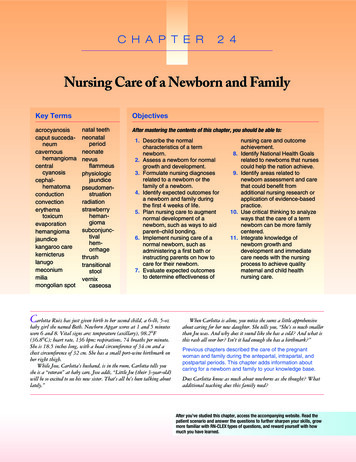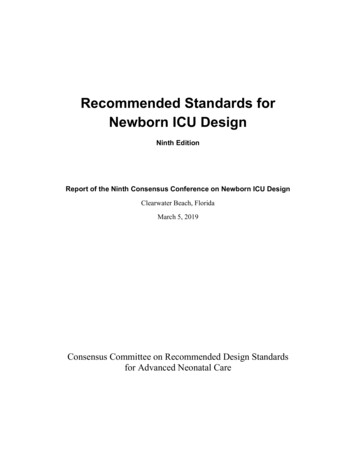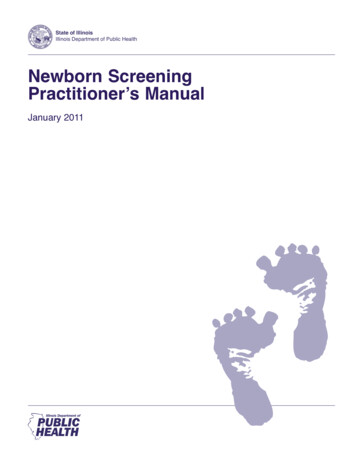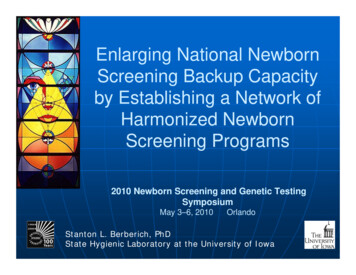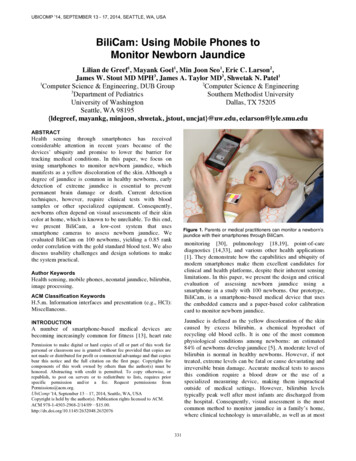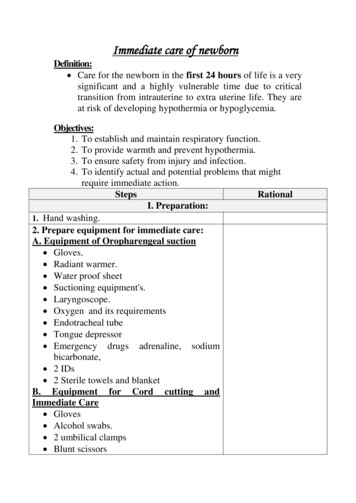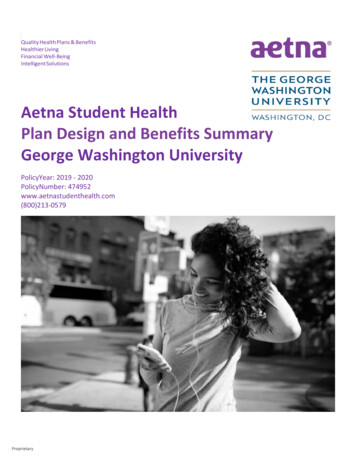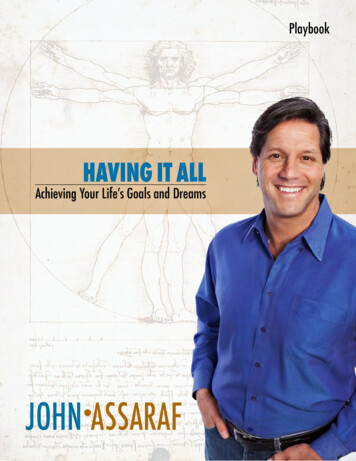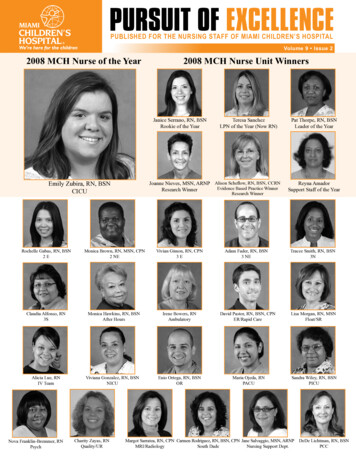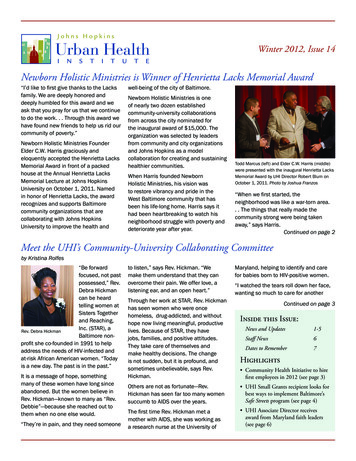
Transcription
Winter 2012, Issue 14Newborn Holistic Ministries is Winner of Henrietta Lacks Memorial Award“I’d like to first give thanks to the Lacksfamily. We are deeply honored anddeeply humbled for this award and weask that you pray for us that we continueto do the work. . . Through this award wehave found new friends to help us rid ourcommunity of poverty.”Newborn Holistic Ministries FounderElder C.W. Harris graciously andeloquently accepted the Henrietta LacksMemorial Award in front of a packedhouse at the Annual Henrietta LacksMemorial Lecture at Johns HopkinsUniversity on October 1, 2011. Namedin honor of Henrietta Lacks, the awardrecognizes and supports Baltimorecommunity organizations that arecollaborating with Johns HopkinsUniversity to improve the health andwell-being of the city of Baltimore.Newborn Holistic Ministries is oneof nearly two dozen establishedcommunity-university collaborationsfrom across the city nominated forthe inaugural award of 15,000. Theorganization was selected by leadersfrom community and city organizationsand Johns Hopkins as a modelcollaboration for creating and sustaininghealthier communities.When Harris founded NewbornHolistic Ministries, his vision wasto restore vibrancy and pride in theWest Baltimore community that hasbeen his life-long home. Harris says ithad been heartbreaking to watch hisneighborhood struggle with poverty anddeteriorate year after year.Todd Marcus (left) and Elder C.W. Harris (middle)were presented with the inaugural Henrietta LacksMemorial Award by UHI Director Robert Blum onOctober 1, 2011. Photo by Joshua Franzos“When we first started, theneighborhood was like a war-torn area. . The things that really made thecommunity strong were being takenaway,” says Harris.Continued on page 2Meet the UHI’s Community-University Collaborating Committeeby Kristina Rolfes“Be forwardfocused, not pastpossessed,” Rev.Debra Hickmancan be heardtelling women atSisters Togetherand Reaching,Inc. (STAR), aRev. Debra HickmanBaltimore nonprofit she co-founded in 1991 to helpaddress the needs of HIV-infected andat-risk African American women. “Todayis a new day. The past is in the past.”It is a message of hope, somethingmany of these women have long sinceabandoned. But the women believe inRev. Hickman—known to many as “Rev.Debbie”—because she reached out tothem when no one else would.“They’re in pain, and they need someoneto listen,” says Rev. Hickman. “Wemake them understand that they canovercome their pain. We offer love, alistening ear, and an open heart.”Through her work at STAR, Rev. Hickmanhas seen women who were oncehomeless, drug-addicted, and withouthope now living meaningful, productivelives. Because of STAR, they havejobs, families, and positive attitudes.They take care of themselves andmake healthy decisions. The changeis not sudden, but it is profound, andsometimes unbelievable, says Rev.Hickman.Maryland, helping to identify and carefor babies born to HIV-positive women.“I watched the tears roll down her face,wanting so much to care for anotherContinued on page 3Inside this Issue:News and Updates1-5Staff News6Dates to Remember7Highlights Community Health Initiative to hirefirst employees in 2012 (see page 3)Others are not as fortunate—Rev.Hickman has seen far too many womensuccumb to AIDS over the years. UHI Small Grants recipient looks forbest ways to implement Baltimore’sSafe Streets program (see page 4)The first time Rev. Hickman met amother with AIDS, she was working asa research nurse at the University of UHI Associate Director receivesaward from Maryland faith leaders(see page 6)
News and UpdatesNewborn Holistic Ministries is Winner of Henrietta Lacks Memorial AwardContinued from page 1Harris called on trusted friends and colleagues and formedNewborn Holistic Ministries in 1996. Their mission was topreserve and enrich life in Baltimore’s Sandtown-Winchester,Upton, and Druid Heights communities by providing servicesto enable residents to meet their material, social, and spiritualneeds.only transformed lives; the programs have also transformedthe corner of Pennsylvania Avenue and Presstman Street.In addition to the complete renovation of six vacant anddilapidated buildings that now house graduates of Martha’sPlace, Newborn has created 8,500 square feet of communitygreen spaces with meditative gardens and murals.Their first major accomplishment came just four years later,with the opening of Martha’s Place, a recovery program forwomen overcoming drug addiction. Harris and his JohnsHopkins collaborator, Lee Bone, found that many women whowent through short-term drug programs quickly relapsed.Martha’s Place picks up where these programs stop througha structured transitional recovery program with a certified sixmonth residential facility and optional permanent housing forgraduates. Martha’s Place Director Angela Long is a graduateof the program and says that an important part of the programis helping the women face the underlying causes of theiraddiction.Lee Bone, who is faculty at Johns Hopkins Bloomberg Schoolof Public Health and has served on the organization’s boardsince its founding, says that Newborn Holistic Ministries isan example of how a small, grassroots community group canbuild something remarkable.“We teach them how to quiet down the mind and begin[thinking about] how they got here,” says Long.Martha’s Place works with more than 25 local agencies andservice providers—including Johns Hopkins—to provide clientswith health care and employment and social services. Theprogram has served over 300 women with about a 50 percentsuccess rate, which is impressive compared to the nationalrecovery rates of 30 percent.In 2008, Newborn Holistic Ministries created a secondmajor community program called Jubilee Arts. In partnershipwith local artists, Baltimore Clayworks, and the MarylandInstitute College of Art, Jubilee Arts offers classes in visualarts, ceramics, dance, and writing to children and adults asan alternative to the dangers of drugs and violence in thecommunity. The program enrolls over 1,000 participants eachyear and features three floors of studio space in the beautifullyrenovated Harris-Marcus Center. Jubilee Arts Director MariskaJordan says that the program is part of the revival of the richarts and cultural legacy of historic Pennsylvania Avenue, whichwas once the hub of African American arts and entertainmentin Baltimore. She also says that involving the community in thearts helps build a sense of pride in areas that, not long ago,seemed to be forgotten.Being able to have public art programs that bring beauty to theneighborhood . . . [shows that] we can do something togetherto make it better,” says Jordan.Over the past 15 years, Newborn Holistic Ministries has notPage 2“This is transforming people’s lives; it’s transforming thecorner; it’s transforming the way [universities] develop andsustain partnerships with the community,” says Bone.Newborn Holistic Ministries President Todd Marcus says thatreceiving the Henrietta Lacks Memorial Award provides atremendous opportunity to grow their work and to form evenmore collaborations across the city. Perhaps his words bestsum up the determination of their skilled and dedicated staff.“We address the unmet needs of our community. We do itbecause if we don’t, it’s not going to get done,” says Marcus.The UHI also congratulates two outstanding Henrietta LacksMemorial Award finalists, the Incentive Mentoring Programand Catholic Charities’ Esperanza Center Health ServicesProgram.A video of the winning organization is available athttp://urbanhealth.jhu.edu.Students learn screen printing in one of the studio spaces at Jubilee Artsduring summer term 2011.http://urbanhealth.jhu.edu
News and UpdatesMeet the CUCCContinued from page 1human being —her baby—but knowing she couldn’t becauseshe had AIDS.”Rev. Hickman couldn’t offer the mother promises of gettingbetter, so instead she offered her compassion. In turn, thewoman introduced Rev. Hickman to her physician—Dr. DorothyBrewster Lee—whose work focused on HIV-positive women.And with that introduction, her life’s work of helping womenwith HIV began.Under Dr. Lee’s tutelage, Rev. Hickman began writing grantsto help address HIV-related issues faced by African Americanwomen in low income, urban areas. Rev. Hickman joined withDr. Lee to organize a Saturday spiritual support group. Shewent to churches and trained women to be “buddies” for otherHIV-positive women, offering to shuttle them to appointments,clean their houses, and help with anything else they needed.Before long, the number of women they had helped reached500, and the organization known as STAR was born.Since STAR’s inception, Rev. Hickman’s work has been locallyand nationally recognized. She was appointed to serve as acommissioner for the Baltimore City HIV Commission, and theWhite House appointed her as an advisor to the CDC and theHealth Resources Services Administration Advisory Committeeon HIV and STD prevention.STAR has helped over 40,000 women, men and youth in thepast twenty years through direct care and prevention servicesutilizing mobile unit and in-house services. An estimated1,200 women and men are serviced in-house and another700 or more are reached through community outreachvenues.For Rev. Hickman, who has a Master’s of Divinity and becameordained in 2004, spirituality is the key to STAR’s success. Shebegins every morning at STAR with a circle of prayer, and sheencourages prayer whenever it is needed. “Someone mightsay, ‘I need you to pray for me now’ and we stop everythingand pray.”But spirituality is more than just prayer, explains Rev. Hickman.It’s about people sharing their true selves with each other andforming a connection.The idea that spirituality can be used to help HIV sparked anNIH-sponsored joint research project between STAR and theUHI known as You Gotta Have Faith! The project, which beganover a year ago, now has a baseline of data that researchersand faith leaders will use to recommend strategies for pastorsto engage with youth and encourage them to make healthydecisions about sex. Explains Rev. Hickman, “The church hasan ongoing audience seeking guidance on how to live, so whatbetter way to communicate this message?”You Gotta Have Faith!, Rev. Hickman hopes, will go a long waytoward protecting at-risk youth, so that the cycle of HIV—andwomen without hope—can be prevented.The UHI is seeking a Program Coordinator to support and grow our work.The full-time position will be involved in the coordination of UHI projects and activities, and willwork to develop policies and systems to ensure the efficiency of daily operations and specificprograms.The complete position description is available at http://jobs.jhu.edu Requisition # 50593.http://urbanhealth.jhu.eduPage 3
News and UpdatesHighlight on 2009 Small Grants Recipients: From Promise to Practice—Keys toSuccessful Implementation of Street Outreach for Youth Violence PreventionBy Bobbi NicoteraIn 2007, the Baltimore City Health Department (BCHD)launched Safe Streets to curb gun violence in Baltimoreneighborhoods. Modeled after Chicago’s CeaseFire program(www.ceasefirechicago.org), which has reported encouragingresults, Safe Streets uses community mediators to reachthose at highest risk for gun violence—especially youth. Thecommunity mediators, who must be very familiar with thecommunity and are often ex-offenders themselves, act as“violence interrupters,” canvassing neighborhoods to diffusepotentially violent situations and helping to find alternativeways to deal with disputes. The mediators even link individualsand their families with opportunities for education andtraining, employment, mental health services, substanceabuse treatment, and more. The mediators help to provideindividuals with options besides a life of crime and violence.The Living Classrooms Foundation received the first contractto implement Safe Streets in East Baltimore—known as SafeStreets East. They started in the McElderry Park neighborhoodand soon expanded to include two adjacent neighborhoods.Eighteen months later, Family Health Centers of Baltimorelaunched the program in the Cherry Hill neighborhood of SouthBaltimore.Safe Streets East staff. Left to right (standing): Gardnel Carter, Tard Carter,Dante Barksdale, Anthony Coleman; left to right (sitting): Corey Peterkin, photoof Leon Faruq, Corey Winfield. Photo courtesy of BCHDDr. Daniel Webster, a violence prevention researcher at JohnsHopkins, was asked by the BCHD to evaluate the impact ofthe program. In a report released in October 2011, Websterand his team of colleagues from the Johns Hopkins Center forPage 4Prevention of Youth Violence found that, while the programeffects varied from neighborhood to neighborhood, SafeStreets had a largely positive influence on the targeted areas.However, even with this promising information, it becameclear in the early stages of the program that successfulimplementation was a complex and challenging task.Webster’s research assistant, PhD student Jennifer MendelWhitehill, recognized the amazing potential of Safe Streets—and also the challenges. She decided to compare Baltimore’sSafe Streets to Chicago’s CeaseFire with the goal of findingthe best ways to implement the program. By examining thespecific activities of both programs, Whitehill suspected thatthe results might also help to explain some of the differencesin outcomes between the two cities.In order to gather data about which practices and polices thestaff perceived to be most helpful in street outreach, Whitehillinterviewed the neighborhood-level program managers andBCHD staff and conducted focus groups with the communitymediators. Leon Faruq, then-director of Safe Streets East,worked closely with Whitehill to develop the project.“Leon and I agreed that the study would complement Dr.Webster’s outcome evaluation by learning from the outreachworkers and translating the experiences from Baltimore intolessons for other communities implementing the program,”said Whitehill.With funding from the UHI Small Grants Program, Whitehillwas able to analyze data from the interviews and focusgroups (additional funding for the larger study, which includeddata collection in Chicago, came from the CDC). She foundsimilarities between the two cities. For example, outreachstaff needed to have street credibility and the capability towork with high-risk individuals. One key difference however,was that Baltimore’s program used an all-in-one approach forstaff. Community mediators acted as violence interruptersas well as service navigators. In Chicago, even though staffmembers were trained in both, the duties were separated.Whitehill’s analysis explored the perceived consequences ofthis difference and found that, among the study participants inboth cities, the overall consensus was that it’s better to havesome dedicated violence interrupters.Another finding from her research was the strong need forconnecting clients with jobs. Many of the program staff felthttp://urbanhealth.jhu.edu
News and UpdatesCommunity Health Initiative to HireFirst Employees in 2012More than two dozen people will be hired next year todocument neighborhood resources in East Baltimore. Thiswork is phase one of the Community Health Initiative’s“asset mapping,” which is a process used to understanda community’s existing resources. The goal of communityasset mapping in East Baltimore is to promote connectionsand relationships between individuals, betweenorganizations, and between individuals and organizations,and to identify where outside resources are needed.that helping the high-risk youth population with obtainingemployment was a key to reducing their chances ofparticipating in violent activities. Whitehill concluded thata renewed effort to partner with job development agencieswould be helpful.“The outcome evaluation shows that the program canbe effective, but only when implemented carefully,” saidWhitehill. “I hope that this study will help Baltimore makesome changes that strengthen the program in existing areasand understand how it could best be implemented in otherneighborhoods that greatly need a reduction in violence.”The asset mapping team will interview East Baltimoreresidents (living within 21202, 21205, 21213, 21224,and 21231) to learn what they like about living in theirneighborhood, how they contribute to the community,and which relationships help get things done. The teamwill also help to identify other kinds of community assetslike churches, neighborhood associations, parks, schools,businesses, and service providers. Each member of theasset mapping team will receive special training after theyare hired. Preference will be given to applicants who livewithin the five zip codes of the Community Health Initiative.For updates about the Community Health Initiative and forposition postings, visit www.healthiereastbaltimore.org.The Community Health Initiative has a new look!The Community Health Initiative now has its own logoand website.Currently the Safe Streets initiative is operating in theMcElderry Park and Cherry Hill neighborhoods. GardnelCarter became the director of Safe Streets East in 2009after Leon Faruq passed away. For more information aboutSafe Streets, go to www.baltimorehealth.org/safestreets.html.Jennifer Mendel Whitehill is currently a postdoctoral fellowwith the Harborview Injury Prevention and Research Centerat the University of Washington.Visit www.healthiereastbaltimore.org for the latestinformation about the Initiative, upcoming meetings, jobpostings, and more.http://urbanhealth.jhu.eduPage 5
Staff NewsDear Friends of the UrbanHealth Institute,This December, I will beleaving the UHI to pursuea new career opportunity.This will be a majortransition for me becauseJohns Hopkins has beenmy home for the past 11years, professionallythat is. I’ve grown uphere in many respects, which makes thedecision incredibly bittersweet.For the past (nearly) four years, I havehandled communications for the UHI. I havebeen both fortunate and challenged by theopportunity to establish strategies thateffectively communicate the work of the UHI.I will take with me all that I’ve learnedover the past decade, and especially thework and experiences I’ve had with the UHI.Specifically, working at the UHI has taughtme much about collaboration and what ittakes to build successful collaborations,whether small-scale or large-scale.In the next phase of my career, I willremain in the non-profit sector. I havethought about jumping ship to the corporateworld, especially because much of mytraditional MBA education focused on turninga profit. However, I have spent my entirecareer in the non-profit world, and I havegrown to love the passion that people havefor their work. It’s very inspiring.I believe in hard work and that peopleshould take responsibility for theirown lives and the lives of their family.That said, I also believe that I live avery fortunate life compared to many inthis world. Helping those who are notas fortunate is extremely rewarding andultimately makes our society a better andhealthier place.I would like to thank my colleagues andpartners for all of their support over theyears. The work you do is so important.Regards,Page 6UHI Associate Director ReceivesAward from Maryland Faith LeadersOn November 21, 2011, UHI Associate Director Philip Leafwas presented with the Agus-Shehan Interfaith LeadershipAward from the Central Maryland Ecumenical Council(CMEC). The CMEC brings together Christian denominationsand their member congregations in Maryland, as well asother faiths, in a united effort for human services andinterfaith dialogue.The award, which is presented at the Annual InterfaithThanksGiving Breakfast, recognizes exceptional individualswho bring together people of different religious traditions toform new relationships and build constructive collaborations.Dr. Leaf was honoredfor his tireless effortsto achieve interfaithunderstanding and forbeing one of the foundersof the Baltimore InterfaithCoalition, a group of faithleaders working to preventviolence and promotehealing among those whoare affected by violence.Dr. Philip Leaf (left) is presented withthe Agus-Shehan Interfaith LeadershipAward.Dr. Leaf was introducedby Baltimore InterfaithCoalition Co-Chair BishopDouglas Miles of KoinoniaBaptist Church.“You will find [Dr. Leaf] inevery community in Baltimore. No where is he a stranger,”said Miles. “There is no task of community importance thathe has not been a part of.”Dr. Leaf says that interfaith collaborations are incrediblyvaluable because they provide a broader understanding ofour diversity and our strengths.“The strength of the ecumenical movement is that it remindsus that there is something greater than ourselves and wecan do a lot of good in the time we are given when we worktogether,” said Leaf.Imam Yahya Hendi, Muslim chaplain at GeorgetownUniversity, was also recognized at the event.http://urbanhealth.jhu.edu
D atestoR ememberDateEventThursday, December 8, 20113:30 pm – 5 pmUHI Symposium featuring Howell S. Baum, author of“Brown” in Baltimore: School Desegregation and the Limitsof LiberalismSheldon HallBloomberg School of Public Health615 N. Wolfe StreetCo-sponsored by the Johns Hopkins School ofEducation and Baltimore City Public SchoolsTuesday, December 13, 201112 pm – 5 pmWednesday, February 8, 20129:00 am - 4:00 pmAll Partners Meeting RetreatCommunity Health InitiativeCreating a Healthier East Baltimore, TogetherUHI Capacity-Building WorkshopPolicy and Media Training WorkshopFor Johns Hopkins researchers and community leadersinterested in affecting urban health policyFriday, April 27, 20129:00 am - 4:00 pmUHI Capacity-Building WorkshopWriting for Success: Preparing Winning GrantsFor community-based organizationshttp://urbanhealth.jhu.eduHumanim at the American Brewery1701 N. Gay StreetBaltimore, MD 21213For more information, contact Catonya Lester atclester@jhsph.edu or 410-502-6155.Location TBAFor more information, contact Catonya Lester atclester@jhsph.edu or 410-502-6155.Location TBAFor more information, contact Catonya Lester atclester@jhsph.edu or 410-502-6155.Page 7
2013 E. Monument StreetBaltimore, MD 21205(410) 502-6155The mission of the Johns Hopkins Urban HealthInstitute is to serve as a catalyst that brings together theresources of Johns Hopkins Institutions with the city ofBaltimore, and especially East Baltimore, to improve thecommunity’s health and well-being.
Newborn Holistic Ministries is Winner of Henrietta Lacks Memorial Award Continued from page 1 Harris called on trusted friends and colleagues and formed Newborn Holistic Ministries in 1996. Their mission was to preserve and enrich life in Baltimore's Sandtown-Winchester, Upton, and Druid Heights communities by providing services
